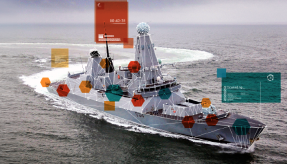
Writing for Defence Online, Mike Sewart, Group Chief Technology Officer at QinetiQ, on the importance of science and technology in defence being able to meet emerging threats.
The way in which warfare is waged has entered a new iteration. Having evolved from pitched battlefields and the seas to the sky just over a century ago, it is now occurring all around us – through the internet, our consumption of media and into space. Technology has been the great equaliser and driving force in opening the world of warfare to new players. With that context, it is unsurprising that we are observing a change in the way in which western states are structuring and preparing their defence forces in response to emerging threats.
As such, the ability of a nation to draw on its science and technology base to explore, experiment, evaluate and exploit new technologies, techniques and tactics will be increasingly vital to future operational advantage, security, and prosperity. Further to this, a nation’s defensive strategy will be strengthened when it can ensure independence in defence development and procurement.
Addressing the growing grey zone
With the increased democratisation of technology, it is no longer just nation states that are able to arm themselves with weapons of war – it can now be done on an individual or group basis too. These weapons of warfare are not the conventional rifle or tank, but rather non-unique computers, which through expert use, give bad actors the ability to inflict damage on their targets. Action in this way is now understood to take place within the grey zone – an area in which bad actors can attack political, economic and military instruments without provoking a conventional response, or even being recognised as formal acts of aggression. The increasing relevance of the grey zone is demonstrated by the number of acts within it making the news and is quickly becoming a constant aspect of warfare.
The way to address such attacks is to gather more intelligence, process it faster, and fuse it to create a clearer picture. This can then be used to diffuse adversarial tactics and underpin informed responses across both security and defence forces.
Traditional military responses have little effect against this type of warfare, which demonstrates the need for the shift towards science and technology. A more concerted effort to adapt defence against all types of attacks, whether traditional or not, is key to the UK’s multi-role forces and the growth in leading edge technology.
Strengthening our standing
The Integrated Review was published at a transitional time for the UK. A year after its formal exit from the EU, the UK now has a specific opportunity to channel its science and technological expertise into strengthening its defence and security capabilities. Particularly within the context of the COVID-19 pandemic and Brexit border disruption, the UK has seen greater emphasis placed on the need to develop its own sovereign operational advantages through homegrown technologies.
According to the Institute of Physics, as of November last year, the UK was on track for science superpower status, giving a boost to the rhetoric around the UK’s technology capabilities. Being able to draw on the reserve of both private and military sector technology experience is crucial, not only for the cost implications of a sovereign technology superiority, but also to the quick and successful roll-out of these services. Developing, optimising and integrating the components needed to create mission-critical capability will be essential to the UK continuing in its role as a world leader in science and technology.
Harnessing the power of experimentation
The ability to move capability solutions quickly, safely and effectively from laboratory to front line is a deterrent in its own right; protracted procurement cycles are incompatible with the need to respond to rapidly changing threats. Achieving technological superiority will need prototyping to be embraced early, including through digital modelling and evaluation.
The value of experimentation in defence has already been realised in several interdisciplinary multinational exercises, such as Formidable Shield which tested eight NATO countries’ defence capabilities versus ballistic missiles. Such exercises accelerate the development and integration of technologies and operating concepts by allowing them to be tested in a controlled, safe environment.
Applying this capability to the grey zone could take the form of incorporating penetration testing and Red Teaming to ensure defenders are prepared. Penetration tests actively attempt to exploit vulnerabilities and exposures in an organisation’s infrastructure, applications, people and processes. Red Teaming, on the other hand, is a scenario-based and goal driven test, with the ultimate aim of emulating the real-world adversaries and attackers who are trying to break into a particular system or steal information.
Welcoming innovation
A significant contributor to the UK’s preparedness will be its ability to marry improved training with the quickened adoption of science and technology. Traditionally slow to take on new forms of technology, the UK needs to accelerate adoption and ensure that forces have the necessary equipment to train and develop capabilities to combat more sophisticated, technology-based attacks.
To achieve this, the UK must enable the transfer of commercial sector technology into military and security use to improve its response to attacks that also stem from the civil sector. For the UK, being an early adopter of disruptive forms of technology will be key in staying ahead of adversaries.
However, to successfully integrate technologies from the civil sector calls for further collaboration with those in the industry. Defence and security forces have first-hand understanding of their operational challenges, while academia and industry are continuously exploring potential solutions; close communication and collaboration between all parties is essential to ensure development and innovation remains mission focused. And this all falls back into the need for a modernised training programme, both in terms of techniques and the tools which are used. Training partnerships with industry and allies will assist in delivering the needed tactical training to combat realistic threats while forging closer cross-government, inter-service and international integration.
A clear path to move along
Britain’s new approach to warfare is aligned with the direction in which warfare is going, and the approach needed to counter emerging threats. Introducing science and technology as a pillar on which to build, will provide the necessary foundation to structure a capable defence in the new workings of the world.
As adversaries increasingly channel their attacks through modern mediums, a developed technological capability will be needed to address them. Acknowledging the power of science and technology is the first step to a capable defence of tomorrow. And as the UK redefines its position on the world stage, advancing our leadership in science and technology provides a platform on which it can stand with other powers. Achieving this will require targeted investment, commitment to innovation and cross-industry collaboration. Together this will ensure the UK’s forces can harness its greatest strengths and be a leader in the development of new technologies, techniques and tactics which will be vital to future preparedness. This should also be married with efforts across the UK’s alliances, to build in the frameworks which can ensure resilience in the long-term.
Mike Sewart is the current Group Chief Technology Officer at QinetiQ and has over 20 years’ experience working with technology. Prior to his current role, Mike served as the Director of Research, Experimentation and Innovation.
QinetiQ is an official DPRTE 2021 event partner
Taking place at Farnborough International on October 5th with elements of the event streamed online, DPRTE 2021 is the UK’s leading defence procurement and supply chain event.
For all involved within buying for or supplying to the defence sector, it’s an unmissable opportunity to hear from and engage with industry leaders, influencers and stakeholders.
To register today as a delegate, follow this link.
To take advantage of exhibitor or sponsor opportunities, please click here.
With DPRTE 2021’s Booking Confidence Guarantee you can now prepare to join the UK’s defence procurement community at DPRTE 2021.
Defence Online is the official media partner for DPRTE 2021
If you would like to join our community and read more articles like this then please click here







